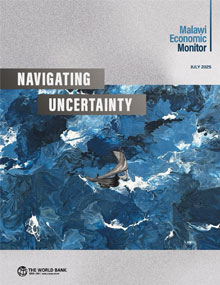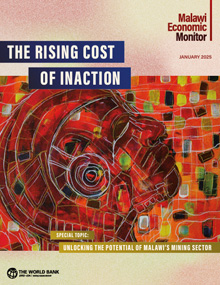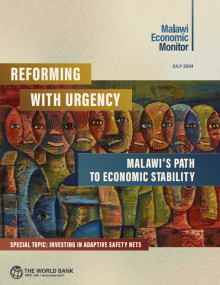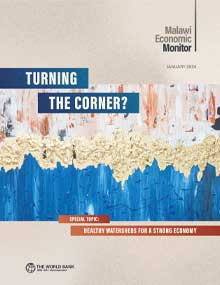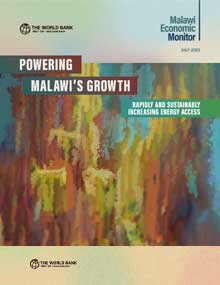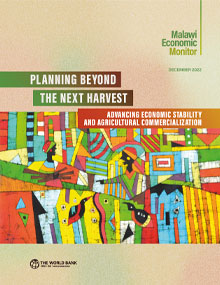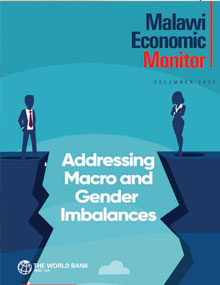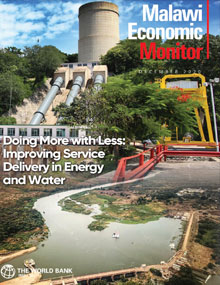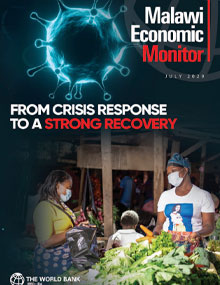The Malawi Economic Monitor (MEM) is a biannual World Bank report series. The MEM provides an analysis of economic and structural development issues and prospects in Malawi. The publication intends to foster better-informed policy analysis and debate regarding the key challenges that Malawi faces in its endeavor to achieve inclusive and sustainable economic growth. It is intended for a wide audience, including policy makers, business leaders, financial market participants, academia, and civil society organizations engaged in Malawi’s evolving economy.
Malawi Economic Monitor
Navigating Uncertainty (#21)
Malawi’s economy is in a deep and protracted crisis marked by elevated inflation, declining living standards, and high rates of food insecurity. Fiscal imbalances are becoming more pronounced due to expenditure overruns and revenue shortfalls, increasing the need for borrowing and deepening current account imbalances. Amidst rising global and domestic uncertainty, macroeconomic stabilization is becoming paramount to avoid a further deterioration of the economy. In order to create the conditions for growth, there is a need to shift from business-as-usual. This will require urgent reforms in three areas: i) Restoring macroeconomic stability; ii) Creating conditions for increased private sector investment and exports; iii) Building resilience and protecting the poor.
The Rising Cost of Inaction (#20)
Malawi’s economic recovery remains fragile due to the slow implementation of macroeconomic adjustment reforms and a series of recent shocks. The cost of inaction is rising, as continued delays in addressing widening fiscal and current account deficits increase the scale of the eventual adjustment and heighten the risk of further deterioration. Realizing Malawi’s significant medium-term growth potential and avoiding a further weakening of the economy will require urgent reforms. The Special Topic section of this edition of the MEM explores how Malawi can leverage its mineral wealth to drive sustainable economic development. Improving the environment for responsible mining investment while simultaneously building government’s capability to govern the sector would significantly address fiscal pressures, stimulate economic growth, create high-quality jobs, and potentially kickstart a broader virtuous cycle of investment and growth.
Reforming with Urgency - Malawi's Path to Economic Stability: Investing in Adaptive Safety Nets (#19)
A drought and an incomplete reform agenda undermine prospects for a rapid economic recovery in Malawi. While implementation of planned macroeconomic and structural reforms is expected to boost GDP growth over the medium term, an El Niño-induced drought has worsened the near-term growth outlook. The drought has compounded longstanding macroeconomic imbalances, with large fiscal deficits, balance-of-payments challenges, unsustainable debt, and price instability weighing on economic activity since 2020. A sustained recovery requires urgently implementing planned reforms. This MEM’s Special Theme emphasizes the importance of greater investment in social protection, building on the strong foundations laid over the last two decades, which will enable Malawi to respond swiftly and effectively to a more volatile global environment and protect poor households from shocks.
Turning the Corner? Health Watersheds for a Strong Economy (#18)
Malawi has recently undertaken various macroeconomic stabilization measures, including adjusting the exchange rate, tightening monetary policy to combat inflationary pressures, implementing fiscal, external, and monetary reforms, as well as a series of structural changes. These actions are expected to address macroeconomic imbalances and contribute to stabilizing the economy, but strong commitment to sustain reforms is essential to facilitate economic recovery. This MEM’s Special Theme emphasizes the importance of prioritizing watershed management to bolster Malawi's economy, including rehabilitating the country’s degraded watersheds, and suggests ways to enhance the involvement of the private sector.
Powering Malawi’s Growth: Rapidly and Sustainably Increasing Energy Access (#17)
Malawi’s economy continues to struggle amidst a devastating cyclone, rising inflation and a protracted macro-fiscal crisis. The economy is weakened by foreign exchange shortages that constrained the importation of essential commodities and production inputs as well as a generally unfavorable external environment. The fiscal deficit remains high despite efforts towards fiscal consolidation. The MEM emphasizes the restoration of macroeconomic stability, the support for growth recovery, and the protection of the poor from shocks. The Special Theme of the 17th MEM highlights that Malawi’s rate of electricity access is among the lowest in the world, and enhancing electricity access is key for economic development and the achievement of Malawi 2063.
Planning Beyond the Next Harvest: Advancing Economic Stability and Agricultural Commercialization (#16)
The combined effects of adverse weather, acute foreign exchange shortages, disruptions to electricity, and the high rate of inflation, mean Malawi continues to face an economic slowdown. This report shows the emerging impacts of the economic crisis where higher government spending continues to widen the fiscal deficit, exerting pressure on the government’s fiscal consolidation plans. Malawi’s public debt is currently assessed to be in distress, though ongoing debt restructuring negotiations will help ensure debt sustainability over the medium term.
Strengthening Fiscal Resilience and Service Delivery (#15)
The 15th Edition of the MEM underscores significant deterioration in the government’s finances, with the deficit reaching its highest level in over a decade. Malawi’s economic growth is expected to decline further due to these chronic imbalances, which have been heightened by severe weather events. The Ukraine-Russia war has added a new crisis to what was already a challenging economic climate, with rising prices for fuel, fertilizer and other commodities impacting foreign reserves and exerting pressure on inflation. While risks to the Malawian economy are tilted to the downside, the government has begun implementing critical policy reforms that are aimed to address macroeconomic imbalances and secure a recovery. In the context of these fiscal constraints, the Special Theme of the 15th MEM highlights the importance of deepening fiscal decentralization, strengthening the intergovernmental fiscal transfer system, and delivering quality services that reach poor and vulnerable households.
Addressing Macro and Gender Imbalances (#14)
Economic growth is projected to pick up from 0.8 percent in 2020 to 2.4 percent in 2021, primarily driven by one-time increases in the agricultural sector. With a population growth rate around 3.0 percent, however, this level of economic growth equates to a contraction in per capita output. Favorable weather, as well as increased fertilizer use due to the Affordable Inputs Program (AIP), led to record harvests. While agriculture accounts for the bulk of overall growth, growth in services and industry sectors has improved but remains tepid. Malawi is beginning a fourth wave of infections induced by the Omicron variant, and the Government has modestly tightened restrictions. With less stringent social distancing policies, demand is improving from low levels. However, the private sector still faces multiple concerns which weigh on performance and investment. These include limited availability of foreign exchange, compulsory liquidation of foreign exchange, inflation on imported items (particularly fuel), perceptions of heavy taxation, limited credit, and cumbersome regulation. Headline inflation has increased to double digits in November and recent price increases have heightened concerns about the cost of living.
Investing in Digital Transformation (#13)
Malawi was affected by a severe second wave of COVID-19 (coronavirus) cases starting in the last weeks of 2020. Case numbers peaked in January and gradually subsided through April, when restrictions were relaxed. Growth in 2020 was strongly affected by the pandemic, falling to an estimated 0.8 percent, down from pre-pandemic projections of 4.8 percent. The pandemic’s impact on the services and industry sectors was partially offset by a strong agricultural harvest. Services and industry slumped amid the ongoing disruptions caused by the pandemic to global value chains and trade and logistics, decreases in tourism and remittances, and dampened demand due to social distancing measures. Agricultural production estimates for 2021 are strong, but the pandemic will still weigh on economic activity. Maize production is expected to increase to 4.5 million tons, a 17 percent increase over 2020’s bumper harvest. Business sentiment is showing some improvement in early 2021 but is still below pre-pandemic levels.
Doing More with Less: Improving Service Delivery in Energy (#12)
The pandemic has induced a sharp recession in many countries across the globe. Malawi's economy has been heavily affected, with growth projected at 1.0 percent in 2020, down from earlier projections of 4.8 percent. With population growth around 3.0 percent, this represents a 2.0 percent contraction in per capita GDP. Global and domestic factors emanating from the pandemic are affecting Malawi's economy, including: 1) disruption in global value chains and trade and logistics; 2) decrease in tourism; and 3) decrease in remittances. Lower international oil prices, on the other hand, have helped reduce the import bill and alleviated fuel and transportation price pressures. Services and industry sectors have been particularly hard hit, leading to a heavier impact in urban areas. However, favorable weather conditions supported a strong agricultural harvest, particularly for maize, which is supporting growth and food security. Yet, production of key export crops, particularly tobacco, have declined. Poverty reduction in Malawi has stagnated in the last 15 years and is expected to worsen with the pandemic. The current account deficit is projected to expand to 19.6 percent of GDP in 2020, up from 17.8 percent in 2019.
From Crisis Response to a Strong Recovery (#11)
Growth improved to an estimated 4.4 percent in 2019, up from 3.5 percent in 2018, reflecting a rebound in agriculture. Improved agricultural production supported stronger performance in the industrial and service sectors. The uptick in growth also indicated resilience in Malawi’s economy in light of the impact of Cyclone Idai and considerable political uncertainty. The full extent of the epidemic’s negative impact is uncertain as the crisis is still unfolding, but a host of external and internal factors are dampening the Malawi economy. Global factors include both supply and demand channels. Disrupted supply chains have reduced imports of key production inputs, particularly from South Africa and China. However, exports from both countries have partially rebounded after their strict containment measures have been reduced earlier in the pandemic. Increased trade logistics costs and delays are also affecting the flow of goods through borders. On the demand side, decreased demand from key trade partners is weighing on exports. Tourism has already been severely affected. Remittances (through money transfer) decreased by 57 percent y-o-y in April before rebounding in May, when they were still 15 percent lower than the year prior.
